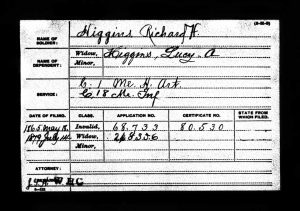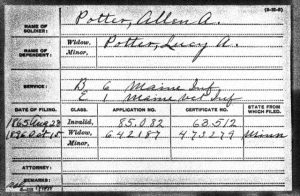 I wrote two years ago about the incredible value of Civil War pensions, but a recent example reminded me that occasionally just getting a valuable pension may be challenging as well. Whenever I realize a Civil War pension exists, whether for a book project or an article, I almost always request it, on the strong likelihood that it will provide further genealogical information, as well as substantial biographical data on the veteran’s life, his widow, and sometimes other family members.
I wrote two years ago about the incredible value of Civil War pensions, but a recent example reminded me that occasionally just getting a valuable pension may be challenging as well. Whenever I realize a Civil War pension exists, whether for a book project or an article, I almost always request it, on the strong likelihood that it will provide further genealogical information, as well as substantial biographical data on the veteran’s life, his widow, and sometimes other family members.
This example involves the pension of Richard H. Higgins (1826–1868) of Trenton, Maine. Richard married Lucy A. King and they had two children, Frederick Tower Higgins (1852–1917) and Annie Pendleton (Higgins) Folley (1866–1937). My friend is a great-great-great-grandson of the son Frederick and, through Richard Higgins, has a descent from Thomas Rogers of the Mayflower; he was interested in joining the Mayflower Society.
However, a problem occurred in trying to establish Frederick Tower Higgins as the son of Richard. While Frederick is enumerated in the Richard Higgins household in the 1860 census, this census does not designate relationships, and Richard died eight years later. No birth record for Frederick has been found, his parents are not listed on either of his two marriage records, and his death certificate only lists his mother Lucy King – no father. Nothing was found in terms of probate or land records. However, I learned that Richard served in the Civil War, and not only did he receive a pension, but his widow Lucy also received a widow’s pension for his service, as the above index card shows.[1]
While Frederick is enumerated in the Richard Higgins household in the 1860 census, this census does not designate relationships…
I felt reasonably confident that proof that Frederick was a son of Richard would be provided in this pension. I made a request to get this pension from the National Archives in Washington as I have done many times before. However, this was the first time I have ever gotten a response that they did not have it!
Well, I’ve gotten that response before for pensions that were active after 1928 and transferred to Veterans Administration and, later, the National Archives in St. Louis. In this case, they probably have it – they just can’t find it! The application numbers on the index are apparently incorrect, and relate to a William Porter of Ohio. This pension had nothing on Richard Higgins. The NARA staff believed that the error was made on the number many years ago, and then repeated on the subsequent indexes, as all three indices have the same set of numbers. There was even a note about this pension on the jacket: “No invalid claim was found on the first search, as seen on the jacket. Subsequently Inv. Ctf. 51126 was found, but got mislaid, and cannot be found on files of Middle Division, or any files in this office,” so it appears the Pension Office was aware of some mix-up back in 1888!
Getting this pension appeared to be a dead-end. Establishing that Frederick was the son of Richard was going to require a proof argument, with the evidence we had, including the death certificate of Fred’s sister, which did list both parents. While not a really difficult argument, as Frederick was clearly connected to his mother Lucy on several documents, it was frustrating that a crystal clear document establishing the connection likely existed, but could not be found.
 My friend then realized that Richard’s widow, Lucy, married secondly Allen A. Potter, who was also a Civil War Soldier from Maine. Allen also received a pension, and Lucy also received a second widow’s pension!
My friend then realized that Richard’s widow, Lucy, married secondly Allen A. Potter, who was also a Civil War Soldier from Maine. Allen also received a pension, and Lucy also received a second widow’s pension!
I wondered if the missing pension of Richard Higgins could actually be in the pension file of Allen and Lucy Potter. We requested this pension, and sure enough, it was! This “double pension” was 120 pages long, with 28 pages relating to Richard Higgins and Lucy’s initial widow’s pension. This pension, as I suspected, listed the date and place of marriage between Lucy and Richard, Richard’s date and place of death, and the names of their two surviving children – Fred and Annie – with their dates and places of birth! On a sad note, Fred himself describes his father’s untimely death, partly attributed to injuries Richard sustained in the war:
That I [Fred T. Higgins] am a son of the claimant Lucy A. Higgins and Richard H. Higgins, deceased. I know that Richard H. Higgins was drowned on Nov 2 – 1868 at Mark Island Light on the coast at Hancock County, Me., off Winter Harbor, I know this from personal knowledge as I saw him floating to sea without any opportunity to save himself. In landing from a boat he was hit by a wave and I believe injured and carried out to sea. One of his arms was useless on account of a gunshot wound received in the service while in Co. C 1 Me. H.A. Vol and at the time of his death he was pensioned and in the employ of the government keeping the Light House. The records of the Light House Board should show his death.
Said Richard H. Higgins has never been seen or heard of since Nov 2 – 1869 [sic, 1868] and his body was never found. One Jennie Harding (present name unknown) saw his body floating out to sea, and the claimant and myself are the only witnesses to the fact of his death.”
This solved any remaining issues for my friend’s Mayflower application, but finding this was perhaps even more rewarding, considering the initial hurdles of getting this linking document!
*
My thanks to my friend Randall Hammond, the great-great-great-great-grandson of Richard H. Higgins, and to Vonnie Zullo for getting these terrific pensions!
Note
[1] This index card is from the index on Ancestry.com; a slightly different index exists on Fold3 (these numbers were the same on both). See https://www.legacytree.com/blog/civil-war-pension-files-research-tips for differences in these indices. Earlier widow’s pensions are also being digitized on fold3.
Wow! What a find! Persistence is everything in genealogy.
Great detective work! So often it’s those hunches that provide the solution. What do you want to bet that when they bunched the two pensions, the person who made the index was looking at the wrong line (Porter vs. Potter)?
When looking on Fold3 at revolutionary war pension papers look backwards and as well as forward in the papers that are presented.
Lower Cape families often have more than one Mayflower line. Your friend probable has a Hopkins line through Rebecca Shaw the first wife of Nathan Young and mother of Elkanah Young who married Mercy Mayo. See Register 151:427 for the argument and look to see if the Mayflower Society has accepted this reasoning.
Great story, good work and example.
Funny you should mention CW pensions. I just ordered and received 10 of them last month. I have received 5 others the past couple of years. However, there is one in particular that cannot be located. I know the widow remarried and now you’ve given me an idea to look at her second husband to see if he had a pension. There are a couple of others missing from my requests also. One of them at NARA says “checked out” but nobody can locate it.
These pension files are genealogical gems in most cases.
In researching an older Irish born man who applied for a Civil War pension from his son, I found an 1867 letter in pension file from Catholic clergy in St. John New Brunswick. The priest and bishop attested to marriage of parents in 1827. St. John had a massive fire in 1877 and records burned. This was an unexpected and valuable document. The date on the church letter was a bit off from the date the elderly widower had claimed was his marriage date, but how many husbands remember their wedding anniversary?
Christopher, would this also occur with rev. War widows? If she re-married, to a man who was not a veteran, would that end her pension?
So the widow of Richard Higgins actually did receive a pension? I must have been interpreting these cards incorrectly for years. I thought if there was an application number (in this case #248359 14 July 1879); but no Certificate number, that meant that the widow did not receive a pension. Or, for that matter, if there is no certificate number for the invalid, that veteran did not receive a pension.